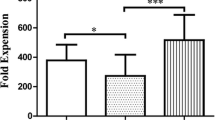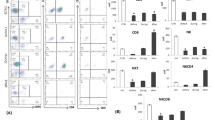Summary
T-cell-growth-factor (TCGF) activated peripheral blood lymphocytes (PBL), cultured for 14 days, showed killer cell activities against natural-killer resistant Daudi cells in a 4 h 51Cr-release assay. However, the effector cells obtained from patients with nonresectable carcinoma exhibited very much lower cytotoxicity to tumor cells. To analyze the mechanism of depression, we have attempted to examine suppressor cell activities of the TCGF-activated PBL. The assay for the suppressor cell activities was made by in vitro inhibition of cell-mediated cytotoxicity by incubating radiolabeled target tumor cells with lymphokine-activated killer (LAK) cells and TCGF-activated PBL. LAK cells were induced by cultivation with recombinant interleukin-2. TCGF-activated PBL, obtained from four out of ten patients with resectable carcinoma and nine out of ten patients with nonresectable carcinoma, significantly suppressed the LAK cell activities. However, this suppression was not observed in TCGF-activated PBL from ten normal healthy control subjects. TCGF-activated PBL with immunosuppressive reactivity were named lymphokine-activated suppressor (LAS) cells. To investigate the phenotypic characterization of TCGF-activated PBL, the cells were analyzed by two-color flow cytometry. TCGF preferentially expanded CD8+CD11− cells and decreased the growth of CD8+CD11+ cells in both normal healthy control subjects and gastric cancer (resectable and nonresectable) patients. Dominantly expressed CD8+CD11− cells on TCGF-activated PBL in patients — especially those with nonresectable gastric carcinoma — showed strong LAS cell activity, irrespective of the presence of killer cell activities of CD8+CD11− cells in TCGF-activated PBL from normal healthy control subjects. The results suggested the generation of CD8+CD11− LAS cells from cancer patients, and revealed that CD8+CD11− T-cells contained killer and/or suppressor cell function. In addition, it was found that the TCGF-activated PBL from gastric cancer patients were associated with an increased proportion of CD4+Leu8+, HLA-DR+CD8+ and HLA-DR+CD25+ cells.
Similar content being viewed by others
Abbreviations
- LAK:
-
lymphokine-activated killer
- TCGF:
-
T-cell growth factor
- PBL:
-
peripheral blood lymphocytes
- rIL-2:
-
recombinant interleukin-2
- LAS:
-
lymphokine-activated suppressor
References
Bensussan A, Acuto O, Hussey RE, Milanese C, Reinherz EL (1984) T3-Ti receptor triggering of T8+ suppressor T-cells leads to unresponsiveness to interleukin 2. Nature 311:565
Böyum A (1968) Isolation of mononuclear cells and granulocytes from human blood. Scand J Lab Invest 21 (suppl 97): 77
Clement LT, Dagg MK, Landy A (1984) Characterization of human lymphocytes subpopulations: alloreactive cytotoxic T-lymphocytes precursor and effector cells are phenotypically distinct from Leu2+ suppressor cells. J Clin Immunol 4:395
Clement LT, Grossi CE, Gartland GE (1984) Morphologic and phenotypic features of subpopulation of Leu-2+ cells that suppresses B-cell differentiation. J Immunol 133:2461
Fleisher TA, Green WC, Uchiyama T, Goldman CK, Nelson DL, Blaese RM, Waldmann TA (1981) Characterization of a soluble suppressor of human B-cell immunoglobulin biosynthesis produced by a continuous human suppressor T-cell line. J Exp Med 154:156
Fox EJ, Cook RG, Lewis DE, Rich RR (1986) Proliferative signals for suppressor T-cells. Helper cells stimulated with pokeweed mitogen in vitro produce a suppressor cell growth factor. J Clin Invest 78:214
Grimm EA, Mazumder A, Zhang HZ, Rosenberg SA (1982) Lymphokine-activated killer cell phenomenon. Lysis of natural killer-resistant fresh solid tumor cells by interleukin-2 activated autologous human peripheral blood lymphocytes. J Exp Med 155:1823
Henney CS, Kuribayashi K, Kern DE, Gillis S (1981) Interleukin-2 augments natural killer cell activity. Nature 291:335
Herzenberg LA, Herzenberg LA (1978) Analysis and separation using the fluorescence-activated cell sorter. In: Weir DW (ed) Handbook of experimental immunology. Blackwell Scientific Publications, London, p 22.1
Japanese Research Society for Gastric Cancer (1981) The general rules for the gastric cancer study in surgery and pathology. Jpn J Surg 11:127
Julius MH, Herzenberg LA (1974) Isolation of antigen binding cells from unprimed mice. J Exp Med 140:904
Klein E, Klein G, Nadkarni JS, Nadkarni JJ, Wigzell H, Clifford P (1968) Surface IgM-kappa specificity on a Burkitt lymphoma cell in vivo and in derived culture lines. Cancer Res 28:1300
Koyama S, Sakita T (1983) Clinical significance of immunosuppressor T cells activated in gastric cancer patients (abstr) Jpn J Med 22:291
Koyama S, Yoshioka T, Sakita T (1980) Suppressor cells in gastric cancer patients. Jap J. Cancer Clin 26:1641
Koyama S, Fujimoto S, Tada T, Sakita T (1981) Effect of Bacillus Calmette-Guérin cell wall skeleton on the induction of the cytotoxic and suppressor T-cells against syngeneic tumor in the mouse. Int J Cancer 27:829
Koyama S, Yoshioka T, Sakita T (1982) Suppression of cell-mediated antitumor immunity by complete Freund's adjuvant. Cancer Res 42:3215
Koyama S, Fukao T, Fujimoto S (1985) The generation of interleukin-2-dependent suppressor T-cells from patients with systemic metastasis of gastric carcinoma and the phenotypic characterization of the cells defined by monoclonal antibodies. Cancer 56:2437
Koyama S, Yoshioka T, Sakita T, Fujimoto S (1985) Generation of T-cell growth factor (TCGF)-dependent splenic lymphoid cell line with cell-mediated immunosuppressive reactivity against syngeneic murine tumor. Eur J Cancer Clin Oncol 21:257
Koyama S, Ebihara T, Fukao K, Osuga T (1987) Differential activation of periferal blood lymphocytes from patients with gastric carcinoma by using a T-cell growth factor and recombinant IL-2. Proc Jpn Cancer Assoc 46:366
Koyama S, Ebihara T, Fukao K, Osuga T (1988) Two-color flow cytometric analyses of the peripheral blood lymphocytes (PBL) and lymphokine-activated PBL in gastric cancer patients. Jpn J. Cancer Clin 34:435
Lamb JR, Feldman M (1982) A human suppressor T-cell clones. Nature 300:356
Landy A, Gartland GL, Clement LT (1983) Characterization of a phenotypically distinct subpopulation of Leu2a+ cells that suppresses T-cell proliferative reponses. J Immunol 131:2757
Lanier LL, Engelman EDG, Gatenby P, Babcock GF, Warner NL, Herzenberg LA (1983) Correlation of functional properties of human lymphoid cells subsets and surface marker phenotypes using multiparameter analysis and flow cytometry. Immunol Rev 74:143
Ledbetter JA, Evans RL, Lipinski M, Cunningham-Rundles C, Good RA, Herzenberg LA (1981) Evolutionary conservation of surface molecules that distinguish T lymphocytes helper/inducer and cytotoxic/suppressor subpopulation in mouse and man. J Exp Med 153:310
Ledbetter JA, Frankel AE, Herzenberg LA, Herzenberg LA (1981) Human Leu T-cell antigens: quantitative expression on normal lymphoid cells and cell lines. In: Hammerling G (ed) Monoclonal antibodies and T-cell hybridomas. Elsevier/North Holland, New York
Reinherz EL, Schlossmann SF (1980) The differentiation and function of human T lymphocytes. Cell 19:821
Rich S, Carpino MR, Arhelger C (1984) Suppressor T cell growth and differentiation. Identification of a cofactor required for suppressor T-cell function and distinct from interleukin-2. J Exp Med 159:1473
Sato T, Sato H, Takahashi S, Koshiba H, Kikuchi K (1986) Specific cytotoxicity of a long-term cultured T-cell clone on human autologous mammary cancer cells. Cancer Res 46:4384
Swain S, Wetzel G, Soubiran P, Dutton R (1982) T-cell-replacing factors in the B-cell response to antigen. Immunol Rev 63:111
Zaring JM, Bach FH (1979) Continuous culture of T-cells cytotoxic for autologous human leukemia cells. Nature 280:685
Author information
Authors and Affiliations
Additional information
This study was supported by a grant-in-aid for scientific research (no. 62570307) from the Ministry of Education, Science and Culture, Japan
Rights and permissions
About this article
Cite this article
Ebihara, T., Koyama, S., Fukao, K. et al. Lymphokine-activated suppressor (LAS) cells in patients with gastric carcinoma. Cancer Immunol Immunother 28, 218–224 (1989). https://doi.org/10.1007/BF00204992
Received:
Accepted:
Issue Date:
DOI: https://doi.org/10.1007/BF00204992




